Shuoyang Ding
Plan2Align: Predictive Planning Based Test-Time Preference Alignment in Paragraph-Level Machine Translation
Feb 28, 2025Abstract:Machine Translation (MT) has been predominantly designed for sentence-level translation using transformer-based architectures. While next-token prediction based Large Language Models (LLMs) demonstrate strong capabilities in long-text translation, non-extensive language models often suffer from omissions and semantic inconsistencies when processing paragraphs. Existing preference alignment methods improve sentence-level translation but fail to ensure coherence over extended contexts due to the myopic nature of next-token generation. We introduce Plan2Align, a test-time alignment framework that treats translation as a predictive planning problem, adapting Model Predictive Control to iteratively refine translation outputs. Experiments on WMT24 Discourse-Level Literary Translation show that Plan2Align significantly improves paragraph-level translation, achieving performance surpassing or on par with the existing training-time and test-time alignment methods on LLaMA-3.1 8B.
Fine-Tuned Machine Translation Metrics Struggle in Unseen Domains
Feb 28, 2024Abstract:We introduce a new, extensive multidimensional quality metrics (MQM) annotated dataset covering 11 language pairs in the biomedical domain. We use this dataset to investigate whether machine translation (MT) metrics which are fine-tuned on human-generated MT quality judgements are robust to domain shifts between training and inference. We find that fine-tuned metrics exhibit a substantial performance drop in the unseen domain scenario relative to metrics that rely on the surface form, as well as pre-trained metrics which are not fine-tuned on MT quality judgments.
Doubly-Trained Adversarial Data Augmentation for Neural Machine Translation
Oct 12, 2021



Abstract:Neural Machine Translation (NMT) models are known to suffer from noisy inputs. To make models robust, we generate adversarial augmentation samples that attack the model and preserve the source-side semantic meaning at the same time. To generate such samples, we propose a doubly-trained architecture that pairs two NMT models of opposite translation directions with a joint loss function, which combines the target-side attack and the source-side semantic similarity constraint. The results from our experiments across three different language pairs and two evaluation metrics show that these adversarial samples improve the model robustness.
The JHU-Microsoft Submission for WMT21 Quality Estimation Shared Task
Sep 17, 2021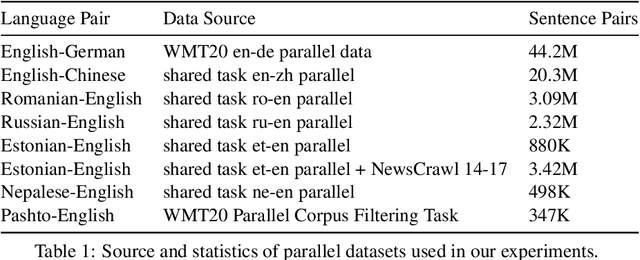
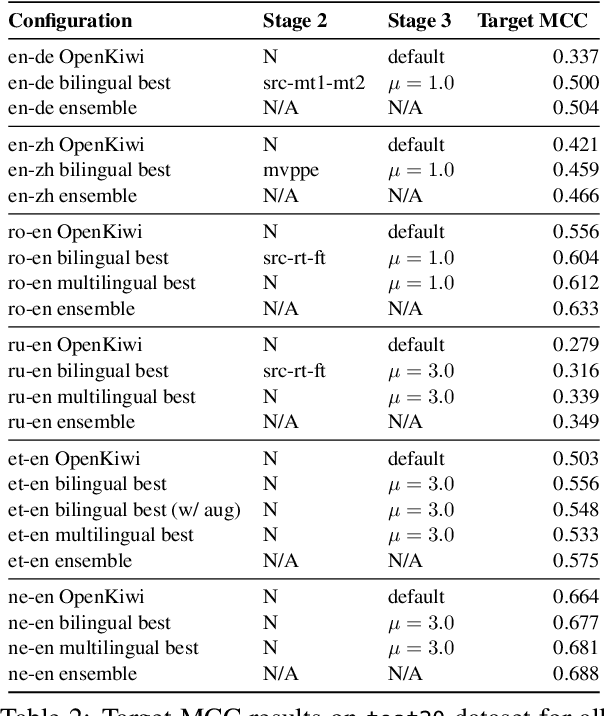
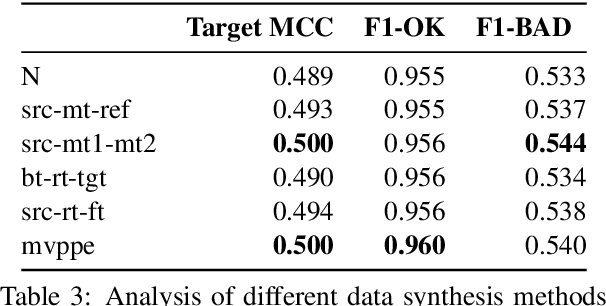
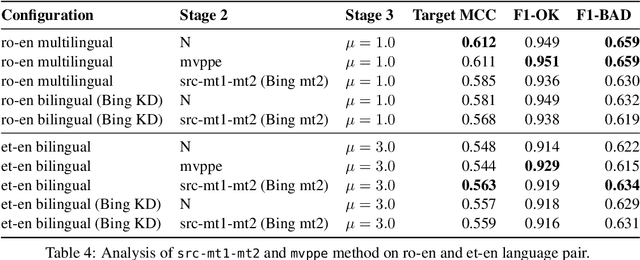
Abstract:This paper presents the JHU-Microsoft joint submission for WMT 2021 quality estimation shared task. We only participate in Task 2 (post-editing effort estimation) of the shared task, focusing on the target-side word-level quality estimation. The techniques we experimented with include Levenshtein Transformer training and data augmentation with a combination of forward, backward, round-trip translation, and pseudo post-editing of the MT output. We demonstrate the competitiveness of our system compared to the widely adopted OpenKiwi-XLM baseline. Our system is also the top-ranking system on the MT MCC metric for the English-German language pair.
Levenshtein Training for Word-level Quality Estimation
Sep 15, 2021
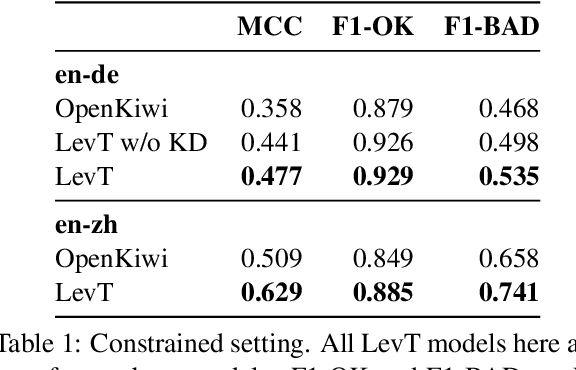
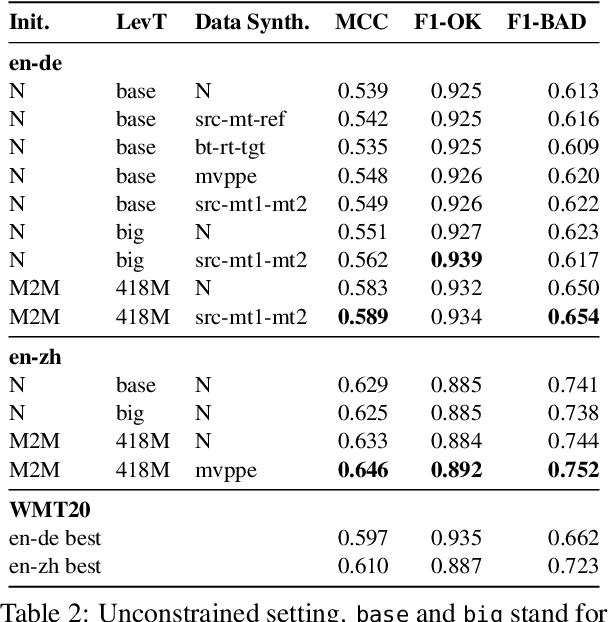
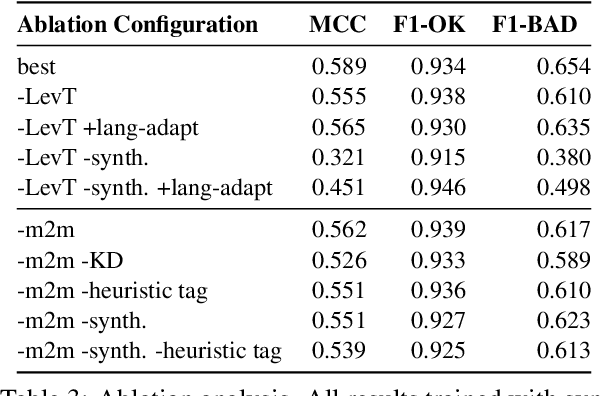
Abstract:We propose a novel scheme to use the Levenshtein Transformer to perform the task of word-level quality estimation. A Levenshtein Transformer is a natural fit for this task: trained to perform decoding in an iterative manner, a Levenshtein Transformer can learn to post-edit without explicit supervision. To further minimize the mismatch between the translation task and the word-level QE task, we propose a two-stage transfer learning procedure on both augmented data and human post-editing data. We also propose heuristics to construct reference labels that are compatible with subword-level finetuning and inference. Results on WMT 2020 QE shared task dataset show that our proposed method has superior data efficiency under the data-constrained setting and competitive performance under the unconstrained setting.
Evaluating Saliency Methods for Neural Language Models
Apr 12, 2021



Abstract:Saliency methods are widely used to interpret neural network predictions, but different variants of saliency methods often disagree even on the interpretations of the same prediction made by the same model. In these cases, how do we identify when are these interpretations trustworthy enough to be used in analyses? To address this question, we conduct a comprehensive and quantitative evaluation of saliency methods on a fundamental category of NLP models: neural language models. We evaluate the quality of prediction interpretations from two perspectives that each represents a desirable property of these interpretations: plausibility and faithfulness. Our evaluation is conducted on four different datasets constructed from the existing human annotation of syntactic and semantic agreements, on both sentence-level and document-level. Through our evaluation, we identified various ways saliency methods could yield interpretations of low quality. We recommend that future work deploying such methods to neural language models should carefully validate their interpretations before drawing insights.
Espresso: A Fast End-to-end Neural Speech Recognition Toolkit
Oct 15, 2019



Abstract:We present Espresso, an open-source, modular, extensible end-to-end neural automatic speech recognition (ASR) toolkit based on the deep learning library PyTorch and the popular neural machine translation toolkit fairseq. Espresso supports distributed training across GPUs and computing nodes, and features various decoding approaches commonly employed in ASR, including look-ahead word-based language model fusion, for which a fast, parallelized decoder is implemented. Espresso achieves state-of-the-art ASR performance on the WSJ, LibriSpeech, and Switchboard data sets among other end-to-end systems without data augmentation, and is 4--11x faster for decoding than similar systems (e.g. ESPnet).
Saliency-driven Word Alignment Interpretation for Neural Machine Translation
Jun 27, 2019



Abstract:Despite their original goal to jointly learn to align and translate, Neural Machine Translation (NMT) models, especially Transformer, are often perceived as not learning interpretable word alignments. In this paper, we show that NMT models do learn interpretable word alignments, which could only be revealed with proper interpretation methods. We propose a series of such methods that are model-agnostic, are able to be applied either offline or online, and do not require parameter update or architectural change. We show that under the force decoding setup, the alignments induced by our interpretation method are of better quality than fast-align for some systems, and when performing free decoding, they agree well with the alignments induced by automatic alignment tools.
A Call for Prudent Choice of Subword Merge Operations
May 24, 2019



Abstract:Most neural machine translation systems are built upon subword units extracted by methods such as Byte-Pair Encoding (BPE) or wordpiece. However, the choice of number of merge operations is generally made by following existing recipes. In this paper, we conduct a systematic exploration of different BPE merge operations to understand how it interacts with the model architecture, the strategy to build vocabularies and the language pair. Our exploration could provide guidance for selecting proper BPE configurations in the future. Most prominently: we show that for LSTM-based architectures, it is necessary to experiment with a wide range of different BPE operations as there is no typical optimal BPE configuration, whereas for Transformer architectures, smaller BPE size tends to be a typically optimal choice. We urge the community to make prudent choices with subword merge operations, as our experiments indicate that a sub-optimal BPE configuration alone could easily reduce the system performance by 3-4 BLEU points.
Parallelizable Stack Long Short-Term Memory
Apr 06, 2019


Abstract:Stack Long Short-Term Memory (StackLSTM) is useful for various applications such as parsing and string-to-tree neural machine translation, but it is also known to be notoriously difficult to parallelize for GPU training due to the fact that the computations are dependent on discrete operations. In this paper, we tackle this problem by utilizing state access patterns of StackLSTM to homogenize computations with regard to different discrete operations. Our parsing experiments show that the method scales up almost linearly with increasing batch size, and our parallelized PyTorch implementation trains significantly faster compared to the Dynet C++ implementation.
 Add to Chrome
Add to Chrome Add to Firefox
Add to Firefox Add to Edge
Add to Edge